

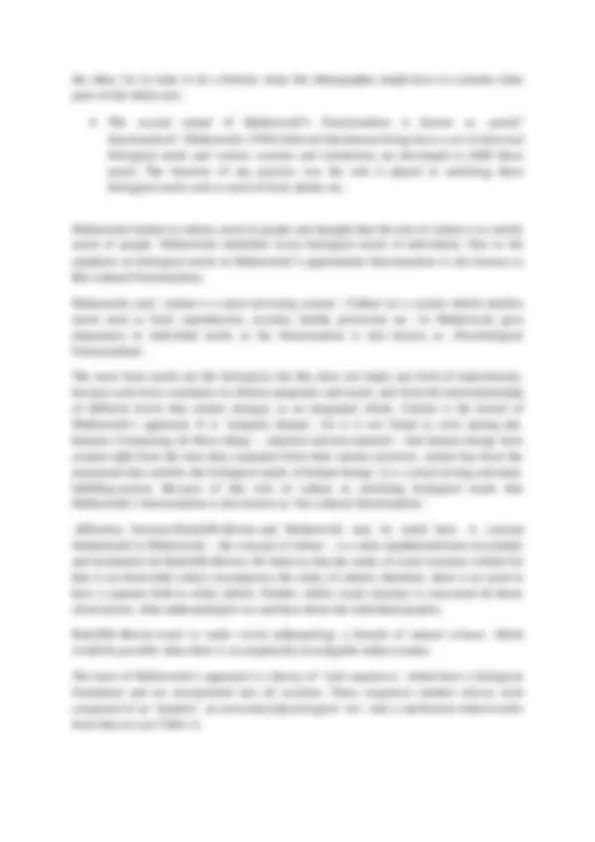
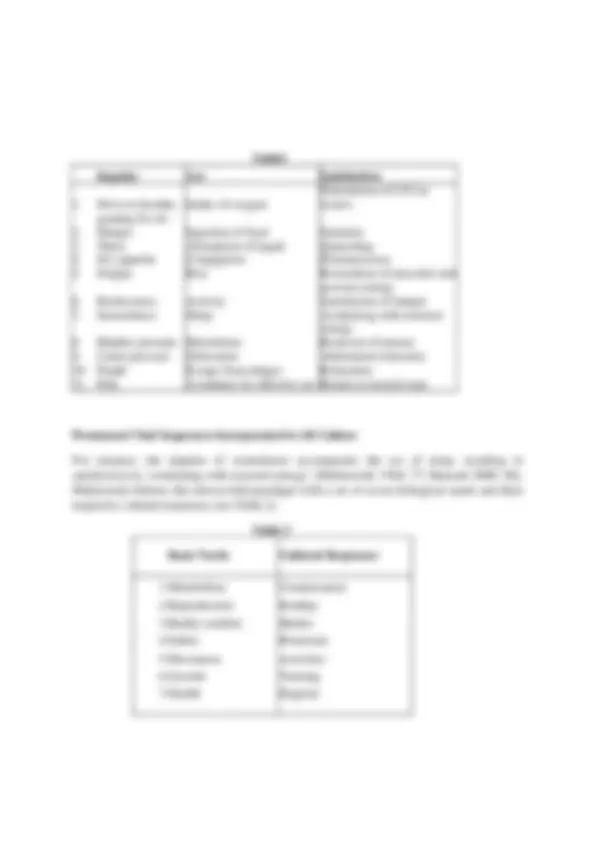
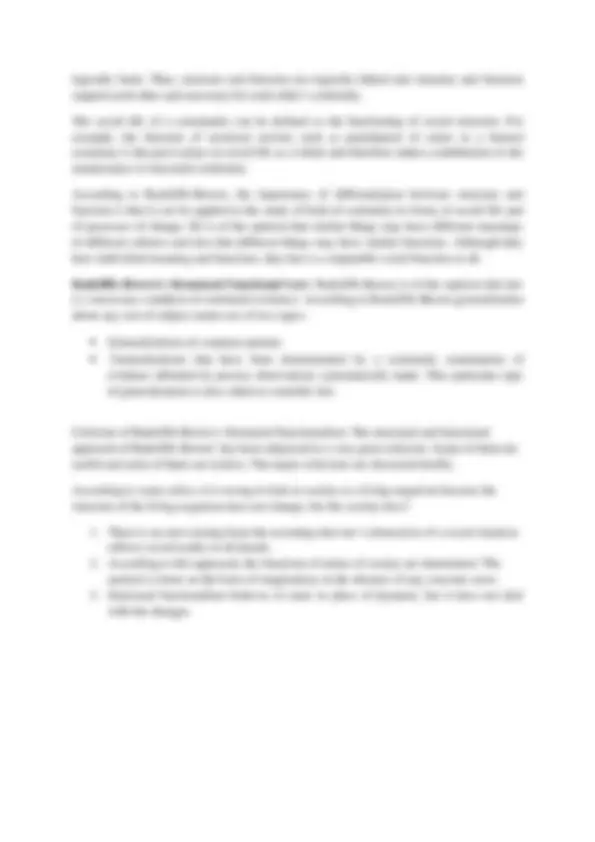
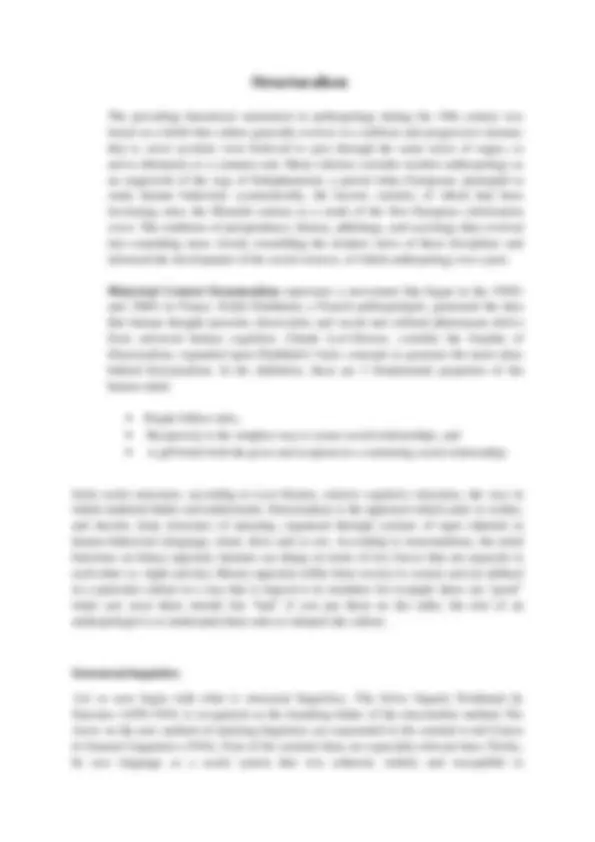
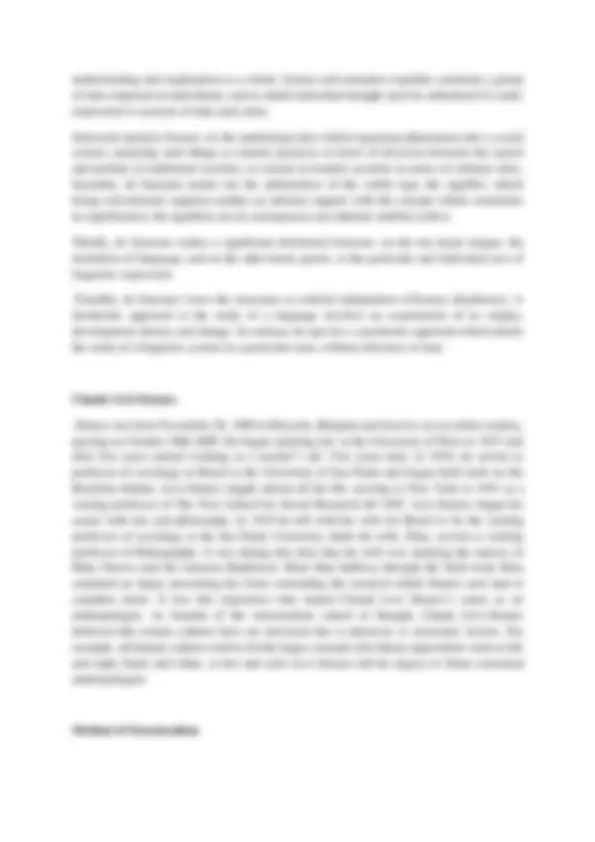



Study with the several resources on Docsity

Earn points by helping other students or get them with a premium plan


Prepare for your exams
Study with the several resources on Docsity

Earn points to download
Earn points by helping other students or get them with a premium plan
Community
Ask the community for help and clear up your study doubts
Discover the best universities in your country according to Docsity users
Free resources
Download our free guides on studying techniques, anxiety management strategies, and thesis advice from Docsity tutors
There are define the concept of theory in anthropology and major theoretical tradtions, main schools functionalism and also types of social structures.
Typology: Lecture notes
Uploaded on 03/31/2022
1 / 13

This page cannot be seen from the preview
Don't miss anything!








Every discipline is grounded on its own set of theories which develop over a particular point of disciplinary history. Unfolding of the discipline can be better understood in terms of its (i) theoretical rigor and (ii) methodological orientation. It’s the theory that provides the broad frame work or orientation for interpretation of facts and the methodology provides specific rules, the logical guidelines for collection and analysis of the data in this regard. Theory provides the template of ideas to think, methodology provides the techniques for collection of ideas so that they can be logically connected to one another in form of a theoretical frame work. Thus theory and methodology are two important basis for sustaining the edifice of the discipline. The most important question remains before us – what is a theory? Theory is a set of propositions or postulates explaining the nature of ‘society’, ‘culture’, ‘human behavior’ and ‘social relationships’. Theories, in simpler terms, are statements that use various concepts and ideas as analytical tools or heuristic devices to explain social phenomena of different scale and magnitude. Theories are generally able to explain a wide range of phenomena through a limited set of central and significant thought categories. Thus concepts constitute the basic elements and logics cement them together. The relationships among these concepts are weaved together in such a manner giving rise to a series of propositions or a grand proposition which is a theoretical explanation of the phenomena. Theory is thus a body of knowledge that explains a wide range of phenomena from different cultural back ground.
There are many anthropological theories within the national traditions of Great Britain and USA. The British School mainly emphasized on the issues of society, social institutions and relationships. While the American tradition focused on culture, cultural beliefs, practices and ideologies. The French tradition explored the intricacies of human mind and its functioning following a universal principle. The anthropological theories we are going to discuss here are: Evolutionism Diffusionism Historical Particularism Functionalism Structure-Functionalism Structuralism
New-ethnography Post-structuralism Post modernism functionalism which has been considered one of the prominent schools of thoughts in order to understand various aspects of culture and society. Functionalism arose as a reaction to evolutionism and diffusionism in early twentieth century. Functionalism looks for the function or part that is played by several aspects of culture in order to maintain a social system. It is a framework that considers society as a system whose parts work together to promote solidarity and stability. This approach of theoretical orientation looks at both social structure and social function. It describes the inter-relationship between several parts of any society. These parts or the constituent elements of a society could be named as norms, traditions, customs, institutions like economy, kinship, religion etc. These parts are interrelated and interdependent. Functionalism was mainly led by Bronislaw Malinowski and A.R. Radcliffe Brown. Both were purely functionalists but their approach slightly differed as Malinowski is known as functionalist but Radcliffe-Brown is mainly known as Structural Functionalist. Malinowski suggested that individuals have physiological needs (reproduction, food, shelter) and these needs are fulfilled by the social institutions. He talked about four basic "instrumental needs" (economics, social control, education, and political organization), that require institutional devices to get fulfilled. While Radcliffe-Brown focused on social structure rather than biological needs. He considered society as a system. He looked at institutions as orderly sets of relationships whose function is to maintain the society as a system. Radcliffe-Brown was inspired by August Comte who was also a functionalist. Bronislaw Malinowski (1884-1942): He was one of the founding fathers of British social anthropology. He did his honours in subjects like mathematics, physics and philosophy and in 1910 he enrolled in the London School of Economics to study anthropology. With Radcliffe- Brown, Malinowski pushed for a paradigm shift in British Anthropology that brought a change from the historical to the present study of social institutions. This theoretical shift gave rise to functionalism and established fieldwork as the constitutive experience of social anthropology. Malinowski's functionalism was greatly influential in the 1920s and 1930s. As applied methodology, this approach worked, except for situations of social or cultural change. However, Malinowski made his greatest contribution as an ethnographer. He also considered the importance of studying social behaviour and social relations in their concrete cultural contexts through participant-observation. He considered it essential to consider the observable differences between what people say they do and what they actually do. His detailed descriptions of Trobriand social life and thoughts are among the well known ethnographies of world and his Argonauts of the Western Pacific (1922) is one of the most widely read works of anthropology. He was one of the leading Functionalists of 20th century.
the other. So in order to do a holistic study the ethnographer might have to consider other parts of the whole also. The second strand of Malinowski‟s Functionalism is known as „needs‟ functionalism‟. Malinowski (1944) believed that human beings have a set of universal biological needs and various customs and institutions are developed to fulfil those needs. The function of any practice was the role it played in satisfying these biological needs such as need of food, shelter etc. Malinowski looked at culture, need of people and thought that the role of culture is to satisfy needs of people. Malinowski identified seven biological needs of individuals. Due to the emphasis on biological needs in Malinowski‟s approach,his functionalism is also known as Bio-cultural Functionalism. Malinowski said,’ culture is a need surveying system’. Culture ios a system which satisfies needs such as food, reproduction, security, health, protection etc. As Malinowski gave importance to individual needs so his functionalism is also known as „Psychological Functionalism’. The most basic needs are the biological, but this does not imply any kind of reductionism, because each level constitutes its distinct properties and needs, and from the interrelationship of different levels that culture emerges as an integrated whole. Culture is the kernel of Malinowski’s approach. It is ‘uniquely human’, for it is not found to exist among sub- humans. Comprising all those things – material and non-material – that human beings have created right from the time they separated from their simian ancestors, culture has been the instrument that satisfies the biological needs of human beings. It is a need-serving and need- fulfilling system. Because of this role of culture in satisfying biological needs that Malinowski’s functionalism is also known as ‘bio-cultural functionalism.’ difference between Radcliffe-Brown and Malinowski may be noted here. A concept fundamental to Malinowski – the concept of culture – is a mere epiphenomenona (secondary and incidental) for Radcliffe-Brown. He believes that the study of social structure (which for him is an observable entity) encompasses the study of culture; therefore, there is no need to have a separate field to study culture. Further, whilst social structure is concerned all about observations, what anthropologists see and hear about the individual peoples. Radcliffe-Brown wants to make social anthropology a branch of natural science, which would be possible when there is an empirically investigable subject matter. The basis of Malinowski’s approach is a theory of ‘vital sequences’, which have a biological foundation and are incorporated into all societies. These sequences number eleven, each composed of an ‘impulse’, an associated physiological ‘act’, and a satisfaction which results from that act (see Table 1).
Table Impulse Act Satisfaction
logically lined. Thus, structure and function are logically linked and structure and function support each other and necessary for each other’s continuity. The social life of a community can be defined as the functioning of social structure. For example, the function of recurrent activity such as punishment of crime or a funeral ceremony is the part it plays in social life as a whole and therefore makes contributions to the maintenance of structural continuity. According to Radcliffe-Brown, the importance of differentiation between structure and function is that it can be applied to the study of both of continuity in forms of social life and of processes of change. He is of the opinion that similar things may have different meanings in different cultures and also that different things may have similar functions. Although they have individual meaning and functions, they have a comparable social function at all. Radcliffe-Brown’s Structural Functional Law: Radcliffe-Brown is of the opinion that law is a necessary condition of continued existence. According to Radcliffe-Brown generalization about any sort of subject matter are of two types: Generalizations of common opinion Generalizations that have been demonstrated by a systematic examination of evidence afforded by precise observations systematically made. This particular type of generalization is also called as scientific law. Criticism of Radcliffe-Brown’s Structural Functionalism: The structural and functional approach of Radcliffe-Brown’ has been subjected to a very great criticism. Some of them are useful and some of them are useless. The major criticisms are discussed briefly: According to some critics, it is wrong to look at society as a living organism because the structure of the living organism does not change, but the society does?
understanding and explanation as a whole. Syntax and semantics together constitute a group of rules imposed on individuals, and to which individual thought must be submitted if it seeks expression to systems of rules and codes. Structural analysis focuses on the underlying rules which organised phenomena into a social system, analysing such things as totemic practices in terms of divisions between the sacred and profane in traditional societies, or cuisine in modern societies in terms of culinary rules. Secondly, de Saussure points out the arbitrariness of the verbal sign, the signifier, which being conventional supposes neither an intrinsic rapport with the concept which constitutes its signification, the signified, nor in consequence any inherent stability with it. Thirdly, de Saussure makes a significant distinction between, on the one hand, langue, the institution of language, and on the other hand, parole, or the particular and individual acts of linguistic expression. Fourthly, de Saussure views the structures as entirely independent of history (diachrony). A diachronic approach to the study of a language involves an examination of its origins, development, history and change. In contrast, he opts for a synchronic approach which entails the study of a linguistic system in a particular state, without reference to time. Claude Lévi-Strauss Strauss was born November 28, 1908 in Brussels, Belgium and lived to see an entire century, passing on October 30th 2009. He began studying law at the University of Paris in 1927 and after five years started working as a teacher’s aid. Two years later, in 1934, he served as professor of sociology in Brazil at the University of Sao Paulo and began field work on the Brazilian Indians. Levi-Strauss taught almost all his life, moving to New York in 1941 as a visiting professor of The New School for Social Research till 1945. Levi-Strauss began his career with law and philosophy. In 1935 he left with his wife for Brazil to be the visiting professor of sociology at the Sao Paulo University while his wife, Dina, served as visiting professor of Ethnography. It was during this time that his wife was studying the natives of Mato Grosso and the Amazon Rainforest. More than halfway through the field work Dina sustained an injury preventing her from concluding the research which Strauss now had to complete alone. It was this experience that started Claude Levi Strauss’s career as an anthropologist. As founder of the structuralism school of thought, Claude Lévi-Strauss believed that certain cultural facts are universal due to physical, or structural, factors. For example, all human cultures tend to divide larger concepts into binary oppositions such as left and right, black and white, or hot and cold. Levi Strauss left his legacy to future structural anthropologists Method of Structuralism
Lévi-Strauss' concept of model formation is influenced by structural linguistics. He uses the de Saussurean dichotomies between: a) langue and parole b) paradigmatic and syntagmatic c) code and message (a spoken language is a code and its message is its substance. In the realm of sign, one's facial expression is a code giving message.) Each society has its own code to transmit a particular message or substance. But there are many other kinds of codes. Each such code is a language and the sum of all such codes is the culture. d) synchrony and diachrony. Structuralism focuses on the effects of universal patterns in human thought on cultural phenomena. Although not attempting to explain these cultural patterns, it rather presents them as a result of the subconscious, of universal human knowledge. This link between societal norms and the mind's thought process is ingrained so deeply within individual cultures, it becomes logical thought, taking specific actions, thoughts and activities and conceptualizing them. The process known as psychic unity, states that the human species, despite differences in race and culture, share the same basic psychological make-up. Even with this universal knowledge, every culture retains its own specific cultural structure. Levi-Strauss presented the idea of binary oppositions. This concept coordinates certain ways of thinking. Examples of binary systems studied could be: "life vs. death," "culture vs. nature," or "self vs. other." Each individual concept has an opposite concept that it is co- dependent on. This is known as unity of opposites; no one of these ideas can exist without the other. Every community takes these concepts and makes them specific to their individual culture. Presenting universal ideas and oppositions, and uniting them under a unique, cultural stand-point, eventually forming a structured and organized society. These ideas relate to linguistic anthropology, in that all humans have a common base for which can create complex sounds and develop different languages. Taking the idea of "phonemes," pairs of sounds that create meaning, and bringing the same concept into structuralism that human share a common base for thought, leading to the development of different cultures stem from the same unconscious roots. Structuralism in Kinship In the studies of the structure of kinship, the systems derive from deeply rooted patterns of human cognition based on logical oppositions of contrastive categories. For example, a contrasting category of kinship could be the relationship within different cultures of immediate family members and marriage. Universally, studies have shown that in almost all cultures there is an incest taboo, marrying a direct family member is not allowed. The taboo demonstrates a universal logical opposition within kin versus non-kin categories. Although every culture has its own ideals and values on the topic of marriage, some including
likely get the meaning of each of the individual messages slightly wrong, but when he puts them together the redundancies and the mutual consistencies